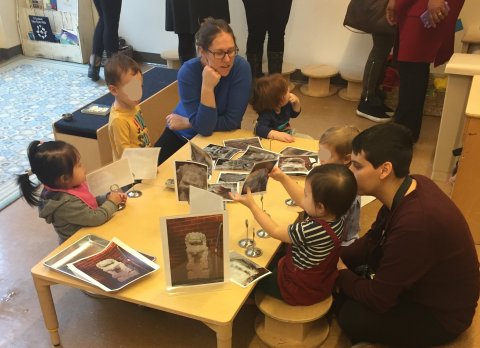Seeing the Details in a Child-Centered Approach
Our visit to the Educational Alliance Preschool
Site Visit Journal | News Post and Reflection | Adding the Teacher's Voice
There are so many reasons we can think of to spend the morning with Jacqueline and Louis! On this particular morning, January 23, 2017, we were fortunate to spend time alongside other educators focusing on the Educational Alliance Preschool’s child-centered approach and their newly opened toddler room. More and more Jewish families are seeking full time care from a younger age, and Educational Alliance Preschool has responded by creating a new high quality infant/toddler center that, in addition to providing childcare, serves as a place where the youngest Jewish learners are not only nurtured, but treated as competent and capable individuals.
We had the privilege of visiting their school earlier in the year, but being there today with a group of dedicated educators in our network interested in furthering their practice helped us see all the little details contributing to the approach and methodology for their successful infant/toddler center and preschool. During our reflection conversations after spending time in the classrooms, three elements emerged that resonated with the educators and permeated the school’s innovative approach: The calmness of play and interactions; The classroom set-up and environment; and The freedom of the children.
Calmness of play and interactions:
After visiting the 2 year old’s classroom, one educator commented, “It surprised me how "chill" the toddler room was, it felt very nurturing and comforting.” This sense of calmness was felt throughout the school, in classrooms of various ages. Contributing factors:
-
Caregiving routines are viewed as an opportunity to enhance communication and build relationships. Even diapering and washing up serve as moments for teachers to build individual connections and help foster children’s independence.
-
Children influence their own activities (for example, deciding a shaving cream exploration should move from the table onto a light box) which leads to a trusting environment. This trust supports the attentiveness and engagement of the children,which in turn leads to prolonged focus on activities
-
Teachers did not talk to one another over the children. The interactions we witnessed were either among the children or between the teachers and the children. Teachers reserved their conversations for other times.

-
Teachers get “underneath” reactions rather than “above” them, remaining calm even amidst situations where children had trouble sharing or became physical. This serves as a model for the children.
Participant quote:
I really appreciated the aesthetics of the school. The nature art work, displays, physical layout of the room, and all the nooks and crannies for the children to find and be in. I also appreciated the way they had one activity out at a time.
Stephanie Shapiro, Agudath Israel Preschool, Caldwell, NJ
Freedom of children
It was evident that teachers work hard to create "yes" environments that support the children’s curiosities and decision making. Contributing factors:
-
Children enjoy self-directed activities as teachers support, observe and facilitate deeper learning
-
Children can flow between independent and group experiences. For example, when a whole class was eating snack together, one child wandered up to the loft and the teachers allowed him the space that he needed in that moment.
-
Beyond choice time, lots of time is given for children to explore the classroom and revisit materials and projects throughout the day.
Room Set-Up and Environment
The classroom is intentionally set-up to be responsive to the needs and ongoing studies and interests of the children in the classroom. Contributing factors:
-
There are many purposefully delineated spaces which allow for varied experiences taking place simultaneously
-
When children need a break from a group experience, there are lots of nooks and crannies, some carved out of unexpected places such as the inside of a cabinet with the doors removed
-
The classrooms feel like an extension of home, with muted colors, soft and adjustable lighting, authentic objects (such as pots and pans) and photos of the children and their families lining the walls
-
Platforms (such as a loft in the toddler room) allow the children to experience different perceptions and perspectives
-
Documentation on the walls was emphasized connections and relationships, connecting school to home and children to the community.
It took a lot of time to establish the structures in place at Educational Alliance, and if you ask them, the process is still ongoing. This year marked the opening of their infant/toddler center with the toddler classroom, and they will be welcoming infants next year. As they and their staff learn more, and deepen the intentionality of their practice, their approach evolves and the experience for the children and their families is further enriched.
Additional resources:
- See our Site Visit Journal Journal documenting our visit to the Educational Alliance where you’ll also find additional photos and resources.
- Listen to Louis describe some of the guiding principles mentioned above, in a Mommybites.com webcast about Care and Curriculum in Early Learning Settings, September 2015.
Yael Kahn Pinto and Shariee Calderone are Education Consultants for Early Childhood and Family Engagement at The Jewish Education Project.